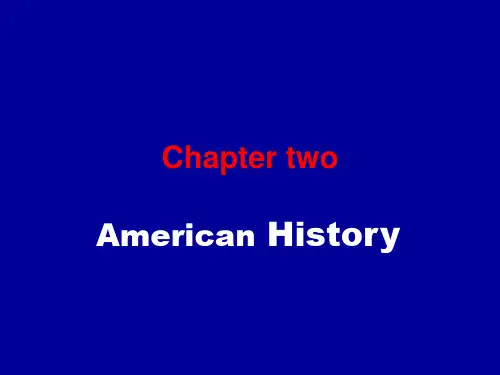美国文化(英语版)教材
- 格式:ppt
- 大小:6.05 MB
- 文档页数:8
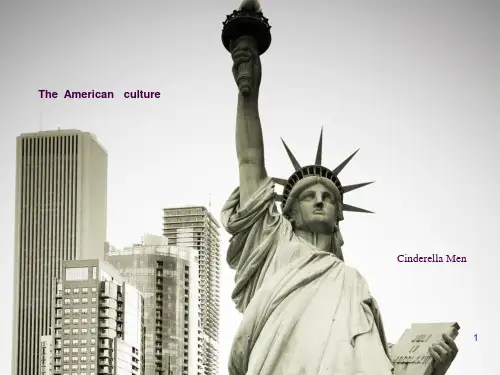
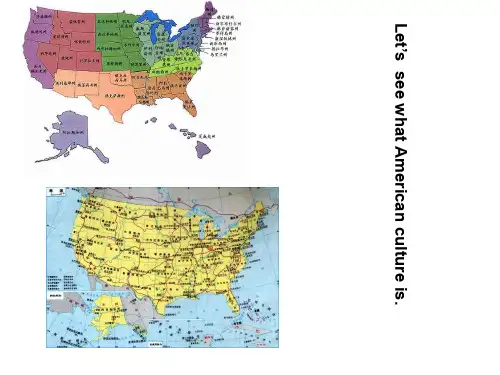

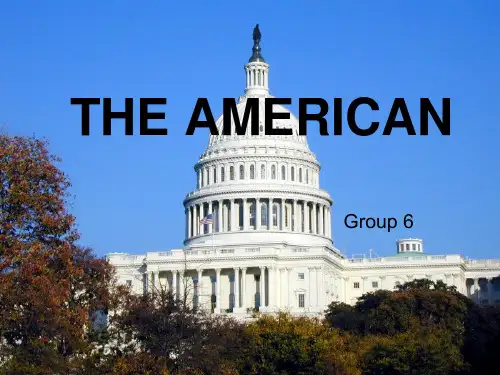
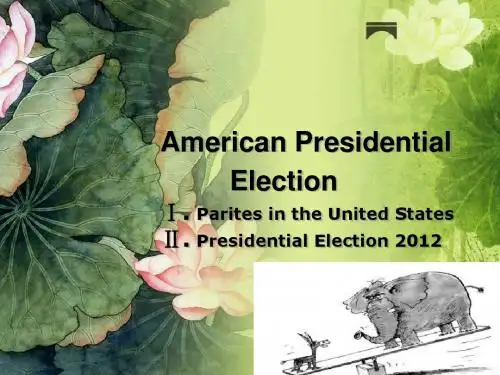

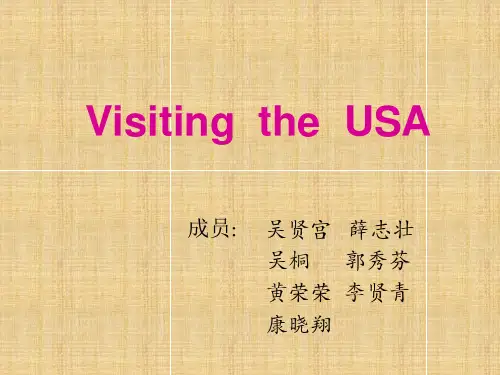
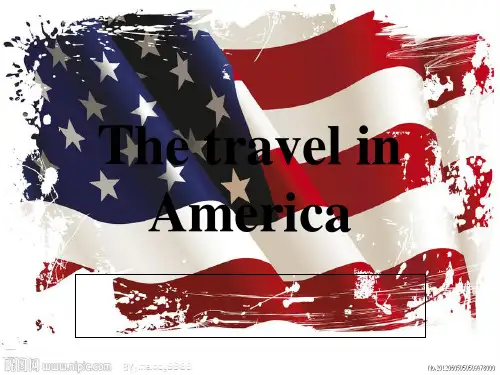
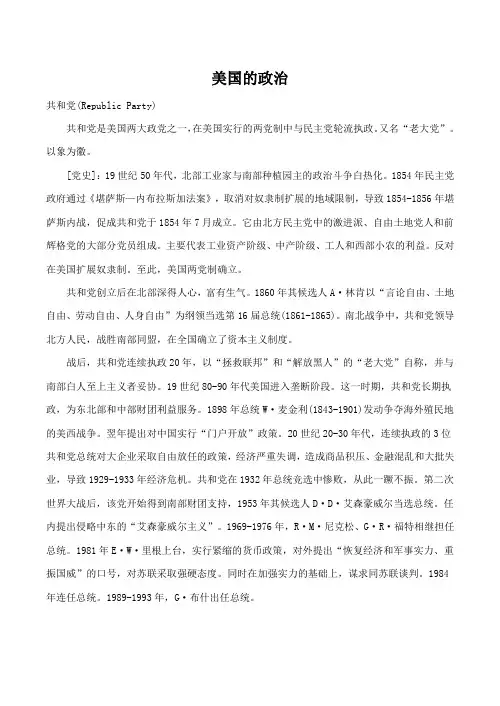
美国的政治共和党(Republic Party)共和党是美国两大政党之一,在美国实行的两党制中与民主党轮流执政。
又名“老大党”。
以象为徽。
[党史]:19世纪50年代,北部工业家与南部种植园主的政治斗争白热化。
1854年民主党政府通过《堪萨斯—内布拉斯加法案》,取消对奴隶制扩展的地域限制,导致1854-1856年堪萨斯内战,促成共和党于1854年7月成立。
它由北方民主党中的激进派、自由土地党人和前辉格党的大部分党员组成。
主要代表工业资产阶级、中产阶级、工人和西部小农的利益。
反对在美国扩展奴隶制。
至此,美国两党制确立。
共和党创立后在北部深得人心,富有生气。
1860年其候选人A·林肯以“言论自由、土地自由、劳动自由、人身自由”为纲领当选第16届总统(1861-1865)。
南北战争中,共和党领导北方人民,战胜南部同盟,在全国确立了资本主义制度。
战后,共和党连续执政20年,以“拯救联邦”和“解放黑人”的“老大党”自称,并与南部白人至上主义者妥协。
19世纪80-90年代美国进入垄断阶段。
这一时期,共和党长期执政,为东北部和中部财团利益服务。
1898年总统W·麦金利(1843-1901)发动争夺海外殖民地的美西战争。
翌年提出对中国实行“门户开放”政策。
20世纪20-30年代,连续执政的3位共和党总统对大企业采取自由放任的政策,经济严重失调,造成商品积压、金融混乱和大批失业,导致1929-1933年经济危机。
共和党在1932年总统竞选中惨败,从此一蹶不振。
第二次世界大战后,该党开始得到南部财团支持,1953年其候选人D·D·艾森豪威尔当选总统。
任内提出侵略中东的“艾森豪威尔主义”。
1969-1976年,R·M·尼克松、G·R·福特相继担任总统。
1981年E·W·里根上台,实行紧缩的货币政策,对外提出“恢复经济和军事实力、重振国威”的口号,对苏联采取强硬态度。
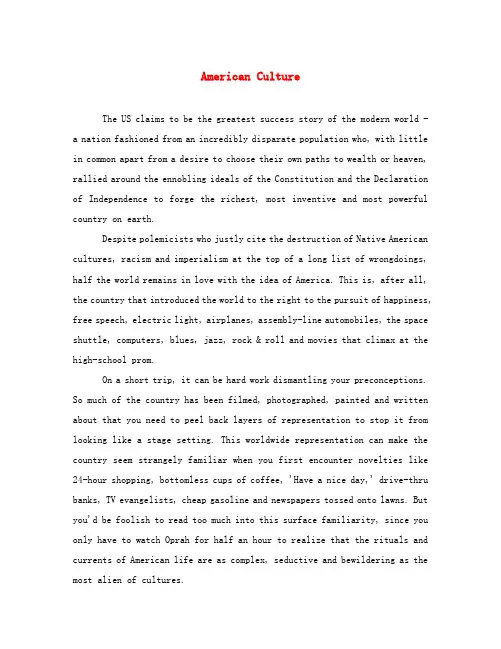
American CultureThe US claims to be the greatest success story of the modern world - a nation fashioned from an incredibly disparate population who, with little in common apart from a desire to choose their own paths to wealth or heaven, rallied around the ennobling ideals of the Constitution and the Declaration of Independence to forge the richest, most inventive and most powerful country on earth.Despite polemicists who justly cite the destruction of Native American cultures, racism and imperialism at the top of a long list of wrongdoings, half the world remains in love with the idea of America. This is, after all, the country that introduced the world to the right to the pursuit of happiness, free speech, electric light, airplanes, assembly-line automobiles, the space shuttle, computers, blues, jazz, rock & roll and movies that climax at the high-school prom.On a short trip, it can be hard work dismantling your preconceptions. So much of the country has been filmed, photographed, painted and written about that you need to peel back layers of representation to stop it from looking like a stage setting. This worldwide representation can make the country seem strangely familiar when you first encounter novelties like 24-hour shopping, bottomless cups of coffee, 'Have a nice day,' drive-thru banks, TV evangelists, cheap gasoline and newspapers tossed onto lawns. But you'd be foolish to read too much into this surface familiarity, since you only have to watch Oprah for half an hour to realize that the rituals and currents of American life are as complex, seductive and bewildering as the most alien of cultures.Come prepared to explore the USA's unique brand of 'foreignness' rather than stay in the comfort zone of the familiar. You'll discover several of the world's most exciting cities, some truly mind-blowing landscapes, a strong sense of regionalism, a trenchant mythology, more history than the country gives itself credit for and, arguably, some of the most approachable natives in the world.Since the September 11, 2001 attacks on the New York's World Trade Center and the Pentagon in Washington, DC, followed with a highly publicized spate of anthrax-laced mailings that exposed government workers, media personnel and mail carriers to the deadly disease, the entire USA has been on a heightened state of alert. Add to this rampant rumors of repercussions for the bombing of Afghanistan, and you're dealing with one nervous country.While your chances of falling victim to shady terrorist plots are probably pretty slim (though you never know; perhaps packing that lucky penny isn't such a silly idea), you are very likely to experience a variety of potentially annoying security protocols, particularly surrounding airline travel. Make sure all your identification and other documents are up-to-date, confirm reservations and bag-checking procedures ahead of time, and arrive at the airport at least an hour before your flight departs.No matter what form of transportation you're using to navigate the USA, however, it behooves the careful traveler to keep an eye on current events during these very interesting times.CultureGive me your tired, your poor/Your huddled masses yearning to breathe free,' reads the inscription on the Statue of Liberty. And the world did, fueling the dynamism of America with waves of ambitious immigrants from everydowntrodden corner of the globe. Immigration is one of the defining characteristics of America's national identity, though calling the US a 'nation of immigrants' neatly sidesteps Native Americans (already here) and African American slaves (brought against their will).In the past 30 years, the old notion of America as a melting pot - a stew in which immigrants' individual differences are lost in uniformity - has given way to the salad-bowl model, in which the individual pieces still retain their flavor while contributing to the whole.Americans are constitutionally guaranteed freedom of worship; dominant faiths include Protestantism, Catholicism and Judaism, among others. There are plenty of indigenous faiths as well, such as Christian Scientists, Jehovah's Witnesses and Mormons.American English encompasses a multitude of regional accents of differing degrees of intelligibility. Spanish has effective dual-language status in parts of southern California, New Mexico, Texas and Miami. There are 400,000 speakers of Native American dialects.Modern American culture is a juicy burger of mass culture garnished with 15 minutes of fame. It owes as much to marketing savvy, communications technology and mass-production techniques as it does to artists and entertainers. If you can name it, American companies have invented, packaged and disseminated it to as many consumers as cheaply and conveniently as possible.The elusive concept of 'American-ness' is often defined by cinema and television. The advent of TV in the 1950s shook Hollywood's hegemony to its core, but both forms of media have managed to coexist, even operating synergistically. The global distribution of American movies and TV shows hasshaped the world's perception of the country to a high, if not completely accurate, degree.The American music industry is the world's most powerful and pervasive, though groundswell movements remain the driving force of American pop. African Americans' influence, including blues, jazz and hip-hop, can hardly be exaggerated.Rap, America's inner-city sound, places an equal emphasis on an ultraheavy beat, sound montage, street cred and macho posturing. Its appeal to middle-class white America will no doubt bemuse sociologists for decades.The US has churned out a veritable forest of literature. The illustrious lineup begins with Walt Whitman, Herman Melville, Nathaniel Hawthorne, Emily Dickinson, Henry James and Edith Wharton, and moves into the modern era with William Faulkner, Ernest Hemingway, Scott Fitzgerald, John Steinbeck, Jack 'Backpack' Kerouac, Arthur Miller, both the Williamses, Saul Bellow, John Updike and Toni Morisson..After WWII, the focus of the international art world shifted from Paris to New York. Artists leaving war-torn Europe brought the remnants of surrealism to the Big Apple, inspiring a group of young American painters to create the first distinct American painting style, abstract expressionism.The relentless ascendancy of mass media gave birth to pop art. Slick, surface-oriented and purposely banal paintings like Andy Warhol's Campbell's Soup Cans are now American icons.When we think of US cities, we think of skyscrapers, those architectural testaments to market forces and American optimism. Chicago isa living museum of high-rise development. New York boasts its fair share of stunners too. Despite increasing homogenization, rural America retains its idiosyncrasies, and distinctive vernacular architectural styles persist in New England (clapboard), California (Spanish Mission) and New Mexico (adobe).American sports developed separately from the rest of the world and, consequently, homegrown games such as baseball, football and basketball dominate the sports scene. Soccer and ice hockey are runners-up to the Big Three. Urban America also invented the great indoors: aerobics and the gym, indoor skiing and rock-climbing - examples of what can go wrong when too much disposable income hits up against too little leisure time.。
